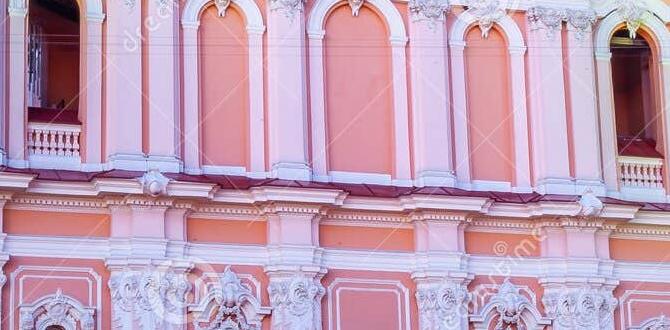Embark on an Antwerp self-guided food tour to discover essential Belgian delights, from crispy fries and rich waffles to decadent chocolate and refreshing beer, making your culinary exploration simple and delicious.
Planning a trip to Antwerp and dreaming of delicious food? Navigating a new city’s food scene can feel a bit overwhelming, especially when you want to taste the absolute best. You might worry about missing out on local specialties or ending up in tourist traps.
But don’t let that stop your taste buds from exploring! This guide makes your Antwerp self-guided food tour easy and incredibly satisfying. Get ready to discover the essential eats that make Antwerp a true culinary gem, and you’ll feel confident and prepared to enjoy every single bite.
Your Essential Antwerp Self-Guided Food Tour: A Taste of Belgium
Welcome to Antwerp, a city where history, fashion, and seriously good food come together. As your guide from Journey Essentials, I’m here to help you craft an unforgettable culinary adventure. Forget complicated reservations or strict schedules; an Antwerp self-guided food tour is all about freedom, discovery, and indulging in the incredible flavors this Belgian city has to offer.
We’ll focus on the must-try items that give Antwerp its foodie reputation, ensuring a delightful experience even for first-time visitors. Packed with practical tips, this guide is your ticket to tasting the best of Antwerp without any hassle.
Why Go Self-Guided?
A self-guided food tour offers unparalleled flexibility. You set the pace, choose your own stops, and can linger where you please. It’s perfect for those who love spontaneity and want to dig a little deeper than the typical tour allows. Plus, it’s often more budget-friendly, giving you control over your spending. For families, it means no rushing or worrying about keeping up, and for solo travelers, it’s a great way to build confidence exploring independently. Think of it as your personalized tasting menu across the city!
Getting Around Antwerp
Antwerp is a very walkable city, especially its historic center where many food highlights are located. For longer distances, the public transport system is efficient. The Antwerp De Lijn network includes trams and buses. Consider purchasing a day pass if you plan on moving around a lot. Many visitors find that combining walking with the occasional tram ride is the perfect mix to cover ground and still soak in the atmosphere.
If you’re traveling with younger children or have mobility concerns, planning your route with public transport in mind is key. For those needing extra support, having comfortable walking shoes is as essential as packing something like adult diapers for peace of mind on long days out, like carrying child diapers for little ones.
The Essential Antwerp Eats: What You MUST Try
Let’s dive into the delicious details! Antwerp, and Belgium in general, is famous for a few key culinary stars. Here’s your essential checklist:
1. Frites (Belgian Fries) & Mayonnaise
You cannot visit Belgium without trying its iconic frites! Unlike other fries, Belgian frites are typically double-fried. This is done in beef fat (or vegetable oil for a vegetarian option these days) to achieve a crispy golden exterior and a fluffy interior. Ask for them “met mayonaise” (with mayonnaise) for the classic experience. There are countless frietkots (fry stands) throughout Antwerp, but seek out those that cook them fresh.
Where to Find Great Frites:
- Consider a local favorite like Frituur No. 1 near the Cathedral.
- Look for stands with a consistent queue of locals – that’s usually a good sign!
2. Belgian Waffles (Gaufres)
There are two main types of Belgian waffles to try: the Brussels waffle and the Liège waffle.
- Brussels Waffles: These are rectangular, light, and airy, often served with toppings like whipped cream, fruit, or chocolate sauce. They are usually eaten with a fork and knife.
- Liège Waffles: These are denser, chewier, and sweeter, made with a brioche-like dough that includes pearl sugar. The sugar caramelizes on the outside when cooked, giving them a unique crunch and sweetness. They are often eaten plain as a delicious street food.
Our Tip:
Try a Liège waffle from a street vendor for a truly authentic on-the-go treat. You can find fantastic ones around the historic city center, especially near the Meir shopping street.
3. Chocolates & Pralines
Antwerp is a chocolate lover’s paradise! Belgian chocolate is world-renowned for its quality and taste. Beyond the mass-produced brands, Antwerp boasts numerous artisan chocolatiers crafting exquisite pralines (filled chocolates). A praline is a chocolate confectionery with a soft center, often a ganache or crème, encased in a chocolate shell.
Artisan Chocolatiers to Explore:
- The Chocolate Line: Known for its innovative and adventurous flavor combinations. Often a flagship stop.
- Dumon Chocolatier: A classic, high-quality chocolatier with a strong reputation.
- Neuhaus: The inventor of the praline, offering a rich history and delicious creations.
When buying, don’t hesitate to ask for recommendations or sample if possible. Think about how you’ll store your chocolates; while not as critical as managing essentials for children like diapers and wipes, keeping them cool and dry ensures they taste their best.
4. Belgian Beer
Belgium is a beer-drinking nation with hundreds of varieties, from light abbey beers to robust Trappist ales. Many beers have unique brewing traditions and specific glasses designed to enhance their flavor and aroma. You’ll find a wide selection in almost any café or bar.
Types to Sample:
- Trappist Beer: Brewed in monasteries, these are often strong and complex (e.g., Chimay, Westmalle).
- Abbey Beer: Brewed in the style of Trappist beers but not by monks themselves.
- Lambic/Gueuze: A spontaneously fermented beer, often sour and complex, originating from the Pajottenland region near Brussels but available throughout Belgium.
- Blonde Ale: A popular, often fruity and spicy ale.
Where to Enjoy:
Any traditional ‘bruin café’ (brown cafe) will offer an excellent selection. For a vast array, consider ‘t Zwart Huis or Den Engel, historic pubs that often serve local specialties.
5. Stoofvlees/Carbonnade Flamande
This is a hearty, traditional Flemish beef stew slow-cooked in beer, often with onions, gingerbread, raisins, and mustard. The beer used infuses the meat with a rich, deep flavor, and the result is incredibly tender and delicious. It’s usually served with frites.
Finding This Dish:
Look for this on the menu at traditional Belgian restaurants or ‘eetcafés’ (eating cafés) in and around the city center. It’s the perfect comforting meal after a day of exploring.
6. Grey Shrimp Croquettes (Garnaalkroketten)
A popular Belgian appetizer, these creamy croquettes are filled with small, grey North Sea shrimp. They are typically coated in breadcrumbs and fried until golden and crispy. The contrast between the crunchy exterior and the smooth, flavorful interior is delightful. They are often served with a simple side salad and a squeeze of lemon.
Best Places to Try:
Many traditional restaurants serve these. It’s a staple on menus that focus on Belgian cuisine. Check out restaurants in the historic harbor area for a good chance of finding excellent, fresh versions.
Planning Your Antwerp Self-Guided Food Tour Route
Here’s a suggested, flexible framework to build your day of delicious exploration. Remember, this is a guide; feel free to swap things around based on your interests and energy levels!
Morning: Sweet Beginnings
Start your day in the historic center. This area is packed with bakeries and chocolatiers.
- Stop 1: Liège Waffle. Grab one from a street vendor as you wander. Enjoy it warm and fresh.
- Stop 2: Chocolate Tasting. Visit an artisan chocolatier like Dumon or The Chocolate Line for a few carefully selected pralines. This is a great time to pick up some edible souvenirs too!
| Eatery Type | Antwerp Speciality | Why It’s Essential |
|---|---|---|
| Street Vendor | Liège Waffle | Caramelized sugar crunch, portable sweet treat. |
| Artisan Chocolatier | Belgian Pralines | Rich, smooth fillings, world-class chocolate craftsmanship. |
| Frietkot (Fry Stand) | Belgian Frites | Crispy outside, fluffy inside, a national icon. |
| Traditional Café | Grey Shrimp Croquette | Savor the delicate flavor of North Sea grey shrimp. |
| Traditional Restaurant | Stoofvlees/Carbonnade Flamande | Hearty, beer-infused beef stew – ultimate comfort food. |
| Beer Café | Belgian Beer (Trappist, Abbey, Blonde) | Experience the depth and variety of Belgian brewing traditions. |
Lunchtime: Savory Delights
By midday, you’ll be ready for something more substantial.
- Stop 3: Frites Break. Head to a reputable frietkot for your first taste of authentic Belgian frites. Enjoy them with a traditional mayonnaise.
- Stop 4: Light Lunch Option. If you want something in between, consider a small cafe for a soup or a simple sandwich. Some places might offer excellent ‘broodjes’ (sandwiches) with local fillings.
Afternoon: Main Course & Brews
This is the time for a true taste of Flemish cuisine.
- Stop 5: Main Dish. Find a traditional restaurant for Stoofvlees/Carbonnade Flamande. This is a meal to be savored.
- Stop 6: Beer Experience. Afterwards, find a cozy ‘bruin café’ to sample some authentic Belgian beer. Ask your server for a recommendation based on your preferences.
Evening: Sweet Finale or Savory Snack
Depending on your appetite and plans, you might opt for another sweet treat or a snack.
- Optional Stop 7: Grey Shrimp Croquettes. If you skipped them for lunch or want another taste, some restaurants offer them as a starter or a snack.
- Optional Stop 8: Another Waffle? If you’re not stuffed, a Brussels waffle with toppings can be a delightful end to your food journey, though it’s more of a dessert item.
Provisions for the Journey: What to Carry
When embarking on a self-guided food tour, comfort and preparedness are key. Just as you’d pack essentials for managing any day-to-day needs or travel challenges, consider what makes your journey smoother.
Essential Travel Comforts:
- Comfortable Walking Shoes: This is non-negotiable for any city exploration, especially when indulging in multiple meals.
- A Small Backpack or Crossbody Bag: To carry your water bottle, map, camera, and any small purchases like chocolates.
- Hand Sanitizer and Wipes: Always handy, especially when you’re eating on the go.
- Reusable Water Bottle: Stay hydrated throughout the day. Antwerp has many public water fountains.
- Portable Charger: To keep your phone or camera powered for navigation and capturing delicious memories.
- Comfort Solutions: For some travelers, having discreet, reliable products like adult protective underwear or child-specific diapers can significantly reduce stress and allow for longer, more enjoyable excursions without worry. Knowing you have these essentials covered frees you up to fully immerse yourself in the travel experience.
Antwerp Food Tour: Practical Tips for Beginners
Here are some straightforward tips to ensure your Antwerp self-guided food tour is a delicious success:
Be Adventurous, But Listen to Your Body
Try different things! Even if you’re not sure about a particular dish, give it a go. However, pace yourself. An Antwerp self-guided food tour isn’t a race. If you start feeling full, take a break, digest, and come back for more later. It’s better to enjoy smaller portions throughout the day than to overeat early on.
Seek Out Local Spots
While major landmarks might have food options, they’re often overpriced and not as authentic. Wander a few streets away from the most crowded tourist areas. Look for places with menus in Dutch (or with a local feel), and especially those with a good mix of locals and tourists. A busy frietkot with a line is usually a strong indicator of quality.
Learn a Few Dutch Phrases
While English is widely spoken, knowing a few basic phrases can enhance your interactions and show respect for the local culture.
- Hello: Hallo or Goedendag
- Thank you: Dank u wel
- Please: Alstublieft
- Yes/No: Ja/Nee
- The bill, please: De rekening, alstublieft
Hydration is Key
Especially when trying rich Belgian foods and beers, staying hydrated with water is crucial. Many cafes will happily refill your water bottle if you ask nicely. Remember, staying comfortable and hydrated is a core principle of stress-free travel, much like ensuring you have the right supplies for any personal needs.
Embrace Spontaneity
The beauty of a self-guided tour is that you can deviate. If you stumble upon a charming café or a bakery that looks irresistible, go for it! That unexpected discovery might become the highlight of your culinary journey.
Consider Allergy and Dietary Needs
If you have allergies or dietary restrictions (e.g., gluten-free, vegetarian), research in advance or be prepared to ask. Many places are becoming more accommodating, especially for vegetarian options. Belgian fries are typically gluten-free, but always confirm the cooking oil and cross-contamination procedures with the vendor.
Frequently Asked Questions
Q1: How much money should I budget for a self-guided food tour in Antwerp?
A1: Budgeting depends on your eating style, but for an essential eats tour, you might spend €30-€60 per person for the day to comfortably try several items like fries, a waffle, some chocolate, a meal, and a beer. This excludes extensive souvenir shopping.
Q2: Is it easy to find vegetarian options in Antwerp?
A2: Yes, increasingly so! While traditional Belgian cuisine is meat-heavy, many restaurants offer vegetarian dishes. Look for vegetable stews, pasta, or salads. Frites are usually vegetarian (check the oil used), and waffles/chocolates are generally safe bets. Many places now clearly label vegetarian choices.
Q3: Can I do an Antwerp self-guided food tour with kids?
A3: Absolutely! Kids will love waffles, frites, and chocolates. Be mindful of portion sizes and maybe share items. Having snacks and drinks readily available, and perhaps packing essentials like child diapers and wipes, can make it more enjoyable for everyone, especially on longer outings.
Q4: How do I avoid tourist traps on my food tour?
A4: Look for queues of locals, venture a few blocks from major attractions, and check online reviews for ‘frietkots’ or cafés. Restaurants with extensive, multilingual menus solely focused on everything Belgian can sometimes be less authentic than simpler, more focused establishments.




